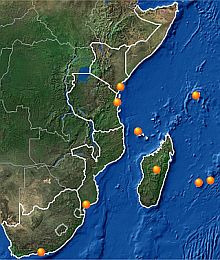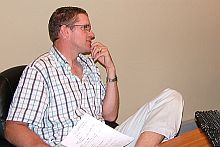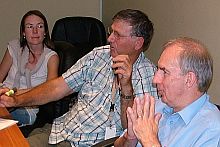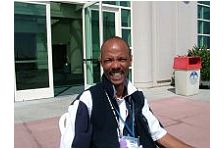SAEON implements SA portal of Nairobi Convention Clearinghouse
|
South Africa is a signatory to the Nairobi Convention, a UNEP (United Nations Environment Programme) initiative which provides a mechanism for regional cooperation, coordination and collaborative actions towards solving interlinked problems of the coastal and marine environment.
The Convention includes ten continental and island states in the western Indian Ocean, focusing on countries that are rich in biodiversity and natural resources. Most of the marine and coastal ecosystems are transboundary in nature and the impacts from human activities often extend across national boundaries.
The Nairobi Convention Clearinghouse (NCCH) is the portal through which to search for, browse and connect to any and all data sets that pertain to the western Indian Ocean coastal and marine environment. Each member State hosts and manages its own portal and these are accessible through the regional portal.
What is the portal's purpose and how does it work?
If you can find any marine or coastal dataset you know exists, as well as a list of others you are happy to discover, through the portal's single point of entry, then it has achieved its main objective.
If the metadata you find enables you to make a decision about whether the data meet your needs, objective number two is met.
Furthermore, if you can then link directly through an 'online linkage' to richer resources such as maps, map services or data downloads, a third major objective has been met.
A search initiated in the regional portal is propagated to each country portal, allowing users to identify regional and cross-border datasets. Examples of Use Cases, or objectives that a user can achieve by using the NCCH include:
- identifying data that already exist for a study area or domain
- assessing the suitability of the data
- visualising the data in graphs, maps, thumbnail images and other media
- downloading the data-identifying planned observation or modelling activities.
A search on the NCCH is a much narrower and more specialised search than a Google search, while at the same time exposing information that might not even be visible to Google.
The core portal content consists of metadata records maintained by participating organisations. Metadata records describe data sets. The more metadata are exposed, the greater the chance that the data they describe will be discovered and used. No data are duplicated in the NCCH. Data sets themselves remain under the care and hosting of their custodians. The NCCH merely provides a search interface, descriptions and links to these data sets.
In cases where a participating organisation is unable to host their own data SAEON can do so, by arrangement.
Who are the intended users?
Users include policy makers, government departments, NGOs, academic researchers and the public.
Why participate in the NCCH mechanism?
Benefits for participating States and organisations include:
- Reduced duplication of data collection and observation activities
- Proper documentation and cataloguing of data sets that represent major investments
- Enhanced chances of discovery and accessibility to data holdings
- Enhanced transparency of marine and coastal conditions
As a signatory to the Nairobi Convention, South African organisations are obliged to contribute to the NCCH. So doing will also complement South African national legislation, policies and guidelines, specifically the SDI (Spatial Data Infrastructure) Act and regulations, the NSIF (National Spatial Information Framework), the South African Earth Observation Strategy (SAEOS) and SAEON's own mandate to co-ordinate, support and curate long-term environmental observations.
Progress of the portal and working group
SAEON was nominated by the Department of Environmental Affairs to be the NCCH country agency for South Africa, which is the last country to fall into place in the Clearinghouse mechanism. Wayne Goschen at SAEON’s Egagasini Node is the country co-ordinator and Gavin Fleming is managing the process and implementing the South African portal.
The South African portal is at http://www.saeonocean.co.za/geonetwork and already contains a few hundred local metadata records as well as a few thousand records harvested from other portals around the world.
A Working Group (WG) has been constituted to oversee the South African portal implementation and ensure its success and sustainability. Organisations represented in the WG are:
- SAEON
- SADCO (South African Data Centre for Oceanography)
- CSIR (Council for Scientific and Industrial Research)
- ASCLME (Agulhas Somali Current Large Marine Ecosystem)
- UCT (University of Cape Town)
- DEA: MCM (Department of Environmental Affairs: Marine and Coastal Management)
- ORI (Oceanographic Research Institute)
- SWIOFP (South West Indian Ocean Fisheries Project)
- ACEP (African Coelacanth Ecosystem Programme)
- IMT (Institute for Maritime Technology)
- ACCESS (Africa Centre for Climate and Earth Systems Science)
- IOI (International Ocean Institute)
The WG held its first meeting at SAEON’s Egagasini Node on 25 February. We were honoured to host Johannes Akiwumi, who is the Head of the Data and Information Management Section of UNEP's Division of Early Warning and Assessment (DEWA). Johannes briefed the WG on the experience of other countries and on what is expected from our WG.
The WG has identified which organisations have data holdings in which domains. Individuals in these organisations are being given accounts on the portal through which they will load and administer metadata records over the coming months.
Work on the portal and the mandate of the WG will be complete in the last quarter of 2010. Thereafter SAEON and participating organisations will continue to maintain the portal and its metadata content.
If you would like to find out more, or if you know of marine or coastal data holdings we should catalogue, please contact the author.














